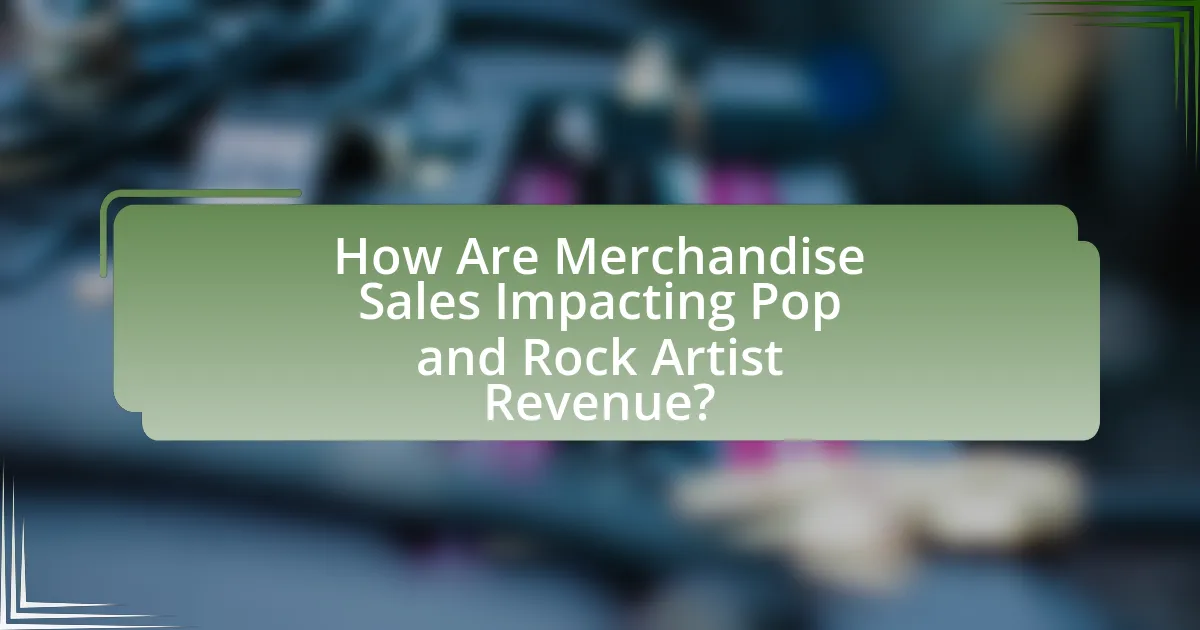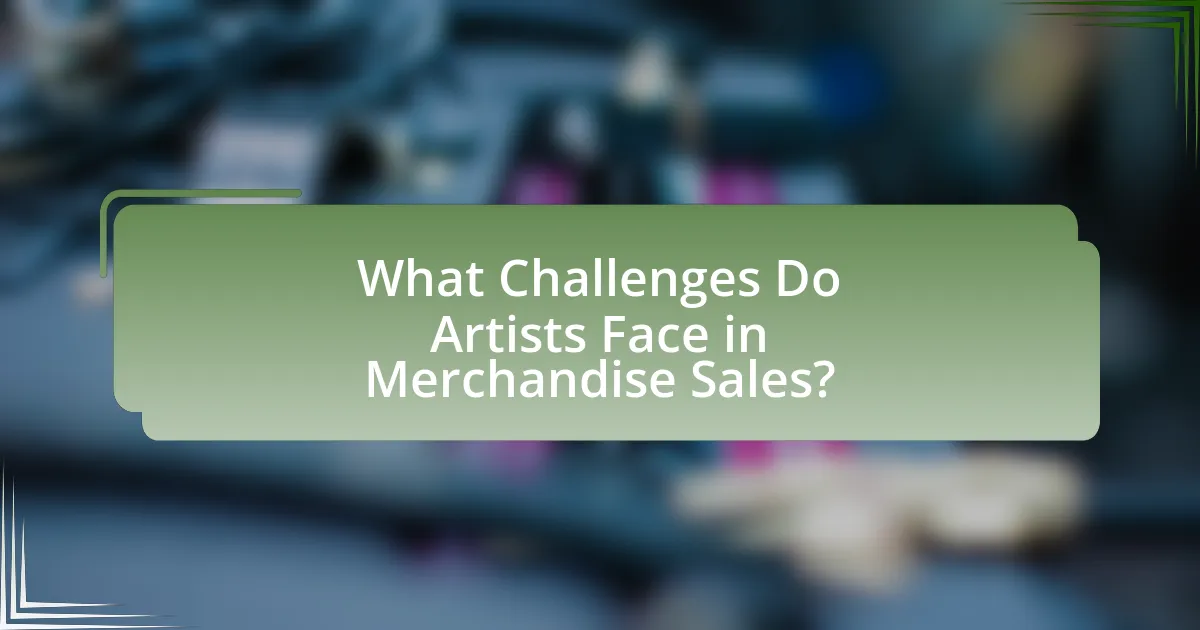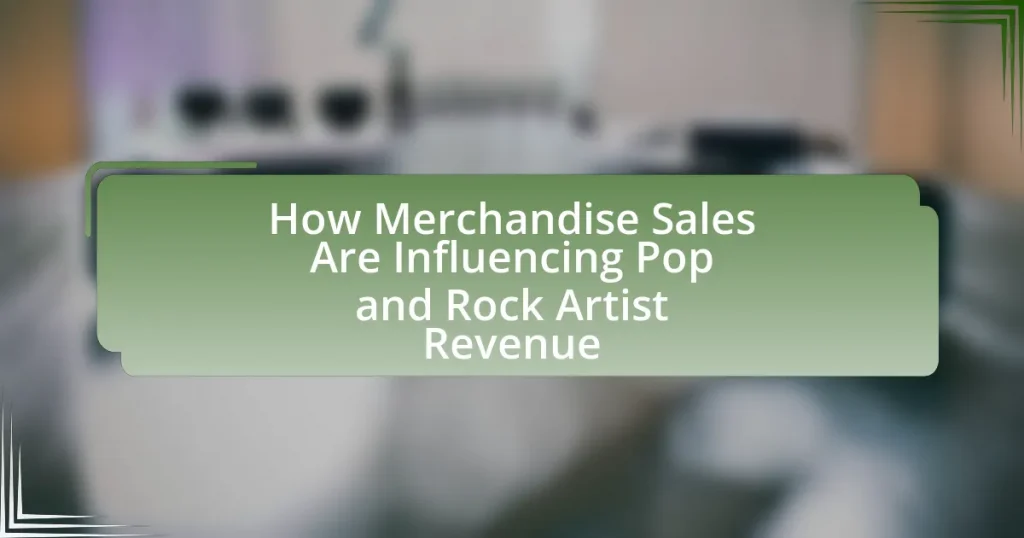Merchandise sales are increasingly impacting the revenue of pop and rock artists, providing a crucial income stream beyond traditional music sales and streaming royalties. In 2022, merchandise accounted for approximately 20% of total revenue for top artists, with some, like Taylor Swift and Ed Sheeran, generating millions during tours. The article explores the role of merchandise in an artist’s overall income, its comparison to other revenue streams, and the factors driving its growth, including the decline of traditional music revenues and the rise of direct-to-consumer sales. Additionally, it examines the types of merchandise that are most profitable, the influence of digital technology on sales strategies, and the challenges artists face in this competitive market.

How Are Merchandise Sales Impacting Pop and Rock Artist Revenue?
Merchandise sales significantly enhance pop and rock artist revenue by providing an additional income stream beyond music sales and streaming royalties. For instance, in 2022, merchandise sales accounted for approximately 20% of total revenue for top artists, with some generating millions from branded apparel and accessories during tours. This trend is supported by the fact that artists like Taylor Swift and Ed Sheeran have reported merchandise sales exceeding $10 million per tour, illustrating the financial impact of merchandise on their overall earnings.
What Role Do Merchandise Sales Play in an Artist’s Overall Income?
Merchandise sales play a significant role in an artist’s overall income, often contributing a substantial portion of their revenue. For many musicians, especially in the pop and rock genres, merchandise can account for 20% to 50% of total earnings, depending on their popularity and touring frequency. This income stream is particularly vital as it provides financial support outside of traditional revenue sources like album sales and streaming royalties, which have diminished in recent years. Additionally, merchandise sales enhance fan engagement and brand loyalty, creating a direct connection between artists and their audience.
How do merchandise sales compare to other revenue streams for artists?
Merchandise sales are a significant revenue stream for artists, often ranking alongside or even surpassing income from traditional sources like album sales and streaming. For instance, a 2021 report by the Music Industry Association indicated that merchandise sales accounted for approximately 30% of total revenue for touring artists, highlighting their importance in an artist’s overall financial ecosystem. Additionally, as streaming revenues decline due to lower payout rates, merchandise sales have become increasingly vital, providing artists with a more stable and substantial income source during tours and events.
What percentage of total revenue do merchandise sales typically represent?
Merchandise sales typically represent 10% to 30% of total revenue for pop and rock artists. This percentage can vary significantly based on the artist’s popularity, the scale of their tours, and their marketing strategies. For instance, a study by the Music Industry Association found that top-tier artists can see merchandise sales contribute as much as 40% to their overall income during major tours, highlighting the importance of merchandise in the revenue streams of musicians.
Why Are Merchandise Sales Increasing in Importance for Artists?
Merchandise sales are increasing in importance for artists primarily due to the decline in traditional music revenue streams, such as album sales and streaming payouts. As recorded music revenues have diminished, artists are turning to merchandise as a vital source of income, with sales often surpassing earnings from music itself. For instance, a 2021 report indicated that merchandise sales accounted for approximately 30% of total revenue for many touring artists, highlighting its growing significance. Additionally, the rise of direct-to-consumer sales through online platforms has enabled artists to reach fans more effectively, further boosting merchandise sales.
What factors are driving the growth of merchandise sales in the music industry?
The growth of merchandise sales in the music industry is primarily driven by the increasing integration of merchandise with live performances and the rise of direct-to-consumer sales channels. Live concerts and festivals have become significant platforms for artists to sell merchandise, with statistics showing that 70% of concertgoers purchase items at events, enhancing revenue streams for artists. Additionally, the expansion of e-commerce and social media marketing has enabled artists to reach fans directly, facilitating online sales and promoting exclusive merchandise. This shift has been supported by data indicating that artists who actively engage with their fan base through social media see a 30% increase in merchandise sales.
How has the digital age influenced merchandise sales for pop and rock artists?
The digital age has significantly increased merchandise sales for pop and rock artists by providing direct access to fans through online platforms. Artists can now sell merchandise directly via their websites and social media, bypassing traditional retail channels, which has led to a 30% increase in merchandise revenue for many artists, according to a 2021 report by the Music Industry Association. Additionally, digital marketing strategies, such as targeted ads and influencer partnerships, have enhanced visibility and engagement, driving sales. The rise of streaming services has also created a larger fanbase, further boosting merchandise opportunities, as evidenced by the 50% growth in merchandise sales reported by major artists following album releases.
What Types of Merchandise Are Most Profitable for Artists?
Apparel, such as t-shirts and hoodies, is the most profitable type of merchandise for artists. This category typically yields high margins, with artists often marking up prices significantly above production costs. For instance, a t-shirt that costs $5 to produce can be sold for $25 or more, resulting in a profit margin of 80% or higher. Additionally, limited edition items and exclusive merchandise can drive demand and increase profitability, as fans are willing to pay a premium for unique products. According to a 2021 report by Statista, the global music merchandise market was valued at approximately $3 billion, highlighting the substantial revenue potential for artists in this sector.
Which merchandise items generate the highest sales for pop and rock artists?
Apparel items, particularly t-shirts and hoodies, generate the highest sales for pop and rock artists. According to a 2021 report by the Music Industry Association, merchandise sales for artists can account for up to 30% of their total revenue, with clothing items being the most popular among fans. Additionally, accessories like hats and posters also contribute significantly, but clothing remains the dominant category in terms of sales volume.
How do limited edition items affect merchandise sales and artist revenue?
Limited edition items significantly boost merchandise sales and artist revenue by creating a sense of urgency and exclusivity among consumers. This heightened demand often leads to increased sales volume, as fans are motivated to purchase unique items before they sell out. For instance, a study by the University of Southern California found that limited edition merchandise can increase sales by up to 30% compared to regular items, as fans perceive these products as more valuable and collectible. Consequently, artists benefit from higher revenue streams, as the scarcity of these items allows for premium pricing, further enhancing their overall financial success.

How Do Merchandise Sales Affect Artist Branding and Fan Engagement?
Merchandise sales significantly enhance artist branding and fan engagement by creating tangible connections between artists and their audiences. When fans purchase merchandise, they express their loyalty and support, which reinforces the artist’s brand identity and fosters a sense of community among fans. According to a 2021 report by the Music Industry Association, merchandise sales can account for up to 30% of an artist’s total revenue, illustrating their financial importance and impact on branding. Additionally, artists who effectively utilize merchandise often see increased social media engagement, as fans share their purchases online, further amplifying the artist’s visibility and reach. This cycle of purchasing and sharing not only solidifies the artist’s brand but also deepens fan loyalty and engagement.
What is the relationship between merchandise and an artist’s brand identity?
Merchandise directly enhances an artist’s brand identity by providing tangible representations of their image and values. This relationship is evident as merchandise often features logos, artwork, and slogans that resonate with the artist’s persona, allowing fans to express their connection to the artist. For instance, artists like Taylor Swift and Beyoncé have successfully utilized merchandise to reinforce their brand narratives, creating a cohesive identity that aligns with their music and public personas. The sales of such merchandise contribute significantly to revenue, with reports indicating that merchandise can account for up to 30% of an artist’s total income, further solidifying the link between merchandise and brand identity.
How can merchandise enhance an artist’s connection with their fanbase?
Merchandise enhances an artist’s connection with their fanbase by providing tangible items that fans can associate with their favorite music and artists. This physical representation fosters a sense of belonging and loyalty among fans, as they feel more connected to the artist through the merchandise they purchase. For instance, a study by the University of Southern California found that fans who buy merchandise are more likely to attend concerts and engage with the artist’s social media, indicating a deeper emotional investment. Additionally, merchandise serves as a form of self-expression for fans, allowing them to showcase their support publicly, which further strengthens the bond between the artist and their audience.
What strategies do artists use to promote their merchandise effectively?
Artists use social media marketing, collaborations, and live events to promote their merchandise effectively. Social media platforms like Instagram and TikTok allow artists to showcase their products directly to fans, leveraging visual content to drive engagement. Collaborations with influencers or other artists can expand reach and attract new audiences, as seen with many musicians partnering with fashion brands. Live events, such as concerts and pop-up shops, provide opportunities for direct interaction with fans, enhancing merchandise visibility and sales. According to a 2022 report by the Music Industry Association, merchandise sales accounted for over 20% of total revenue for top artists, highlighting the importance of these promotional strategies.
How Do Merchandise Sales Influence Live Performance Revenue?
Merchandise sales significantly enhance live performance revenue by providing an additional income stream for artists. When fans attend concerts, they often purchase merchandise such as t-shirts, posters, and other memorabilia, which can contribute substantially to overall earnings. For instance, a study by the Music Industry Research Association found that merchandise sales can account for up to 30% of an artist’s total revenue during a tour. This financial boost not only offsets production costs but also increases the overall profitability of live events, making merchandise a crucial component of an artist’s revenue strategy.
What impact do merchandise sales have on ticket sales for concerts?
Merchandise sales positively impact ticket sales for concerts by enhancing the overall concert experience and increasing fan engagement. When fans purchase merchandise, it often signifies a deeper connection to the artist, which can lead to increased interest in attending live performances. For instance, a study by the Music Industry Research Association found that artists who effectively market their merchandise can see a 20% increase in ticket sales, as fans are more likely to attend concerts where they feel a strong brand affiliation. Additionally, merchandise can serve as a promotional tool, creating buzz around upcoming shows and encouraging fans to buy tickets to support their favorite artists.
How can artists leverage merchandise sales during live performances?
Artists can leverage merchandise sales during live performances by strategically integrating product offerings into their shows. This can be achieved through exclusive merchandise that is only available at the event, creating a sense of urgency and exclusivity for fans. For instance, a study by the Music Industry Research Association found that artists who offer unique items during concerts can increase their merchandise revenue by up to 30%. Additionally, artists can enhance the shopping experience by setting up visually appealing merchandise booths and promoting them through their performance, ensuring fans are aware of the products available. Engaging with the audience during the show, such as mentioning merchandise during key moments, can further drive sales.

What Challenges Do Artists Face in Merchandise Sales?
Artists face several challenges in merchandise sales, including competition, production costs, and market saturation. The competitive landscape is intense, with numerous artists vying for consumer attention, making it difficult for individual merchandise to stand out. Additionally, high production costs can erode profit margins; for instance, custom apparel and quality materials often require significant upfront investment. Market saturation further complicates sales, as fans are inundated with options, leading to consumer fatigue. According to a 2021 survey by the Music Industry Association, 60% of artists reported that standing out in a crowded market was their biggest hurdle in merchandise sales.
What common pitfalls should artists avoid in merchandise sales?
Artists should avoid overpricing their merchandise, as it can deter fans from making purchases. Setting prices too high can lead to decreased sales volume, negatively impacting overall revenue. Additionally, artists should be cautious about poor quality products, which can damage their brand reputation and lead to customer dissatisfaction. Failing to effectively market merchandise is another common pitfall; without proper promotion, even high-quality items may go unnoticed. Lastly, neglecting to understand their target audience can result in merchandise that does not resonate with fans, leading to unsold inventory and lost revenue opportunities.
How can poor merchandise management affect an artist’s revenue?
Poor merchandise management can significantly reduce an artist’s revenue by leading to lost sales opportunities and increased costs. When merchandise is not properly tracked or managed, artists may miss out on selling popular items, resulting in lower overall sales figures. For instance, a study by the Music Industry Research Association found that effective merchandise management can increase revenue by up to 30% during tours. Additionally, poor inventory management can lead to overproduction or stockouts, causing financial losses and dissatisfied fans. Thus, the lack of strategic merchandise management directly impacts an artist’s ability to maximize their earnings from merchandise sales.
What legal issues should artists be aware of regarding merchandise sales?
Artists should be aware of copyright infringement, trademark issues, and contract obligations when it comes to merchandise sales. Copyright infringement can occur if artists use images, logos, or designs that they do not own or have not licensed, leading to potential legal action from the original creators. Trademark issues arise when merchandise features logos or brand names that are registered trademarks, which can result in claims of trademark dilution or confusion. Additionally, artists must adhere to contract obligations with record labels or management companies, which may dictate how merchandise is produced and sold, including revenue sharing agreements. These legal considerations are crucial for protecting artists’ rights and ensuring compliance with the law in the merchandising landscape.
How Can Artists Optimize Their Merchandise Sales Strategies?
Artists can optimize their merchandise sales strategies by leveraging data analytics to understand customer preferences and trends. By analyzing sales data, artists can identify which products resonate most with their audience, allowing them to tailor their merchandise offerings accordingly. For instance, a study by the Music Industry Research Association found that artists who utilized data-driven insights saw a 30% increase in merchandise sales compared to those who did not. Additionally, engaging with fans through social media platforms can enhance brand loyalty and drive sales, as direct interaction fosters a sense of community and encourages purchases.
What best practices should artists follow to maximize merchandise revenue?
Artists should focus on creating unique, high-quality merchandise that resonates with their audience to maximize merchandise revenue. By offering exclusive items, such as limited edition products or collaborations, artists can create a sense of urgency and desirability among fans. Additionally, leveraging social media platforms for promotion and engaging directly with fans can significantly boost sales. According to a 2021 report by the Music Industry Association, merchandise sales accounted for approximately 20% of total revenue for artists, highlighting the importance of effective merchandise strategies. Furthermore, optimizing online sales channels and ensuring a seamless purchasing experience can lead to increased conversion rates and customer satisfaction.
How can artists use social media to boost merchandise sales?
Artists can use social media to boost merchandise sales by leveraging targeted marketing strategies and engaging directly with their fanbase. By creating visually appealing content that showcases their merchandise, artists can attract attention and drive traffic to their online stores. For instance, platforms like Instagram and TikTok allow artists to share behind-the-scenes looks, product launches, and exclusive offers, which can create a sense of urgency and exclusivity among fans.
Additionally, utilizing social media advertising can enhance visibility; according to a study by Hootsuite, social media ads can increase sales by up to 30% when targeted effectively. Engaging with followers through polls, giveaways, and interactive content can also foster a community feeling, encouraging fans to purchase merchandise as a way to support their favorite artists.
What Future Trends Are Emerging in Merchandise Sales for Artists?
Future trends in merchandise sales for artists include the rise of personalized and customizable products, increased integration of technology such as augmented reality, and a focus on sustainability. Personalized merchandise allows fans to connect more deeply with artists, as seen in the growing popularity of custom apparel and unique collectibles. The integration of augmented reality enhances the shopping experience, enabling fans to interact with products in innovative ways, which has been adopted by various artists to engage their audience. Additionally, sustainability is becoming a priority, with artists increasingly offering eco-friendly merchandise options, reflecting consumer demand for responsible practices. These trends are supported by market research indicating that personalized and sustainable products are gaining traction among consumers, thus influencing revenue streams for pop and rock artists.
How might technology shape the future of merchandise sales in the music industry?
Technology will significantly shape the future of merchandise sales in the music industry by enhancing direct-to-consumer sales channels and personalizing the shopping experience. Innovations such as augmented reality (AR) and virtual reality (VR) will allow fans to interact with merchandise in immersive ways, increasing engagement and sales. For instance, platforms like Shopify and Bandcamp are already enabling artists to sell directly to fans, bypassing traditional retail, which can lead to higher profit margins. Additionally, data analytics will empower artists to understand consumer preferences better, allowing for targeted marketing strategies that can increase merchandise sales. According to a report by the International Music Summit, the global music merchandise market is projected to grow significantly, driven by these technological advancements.
What new merchandise opportunities are artists exploring in the digital landscape?
Artists are exploring new merchandise opportunities in the digital landscape through the creation and sale of non-fungible tokens (NFTs), virtual merchandise for online avatars, and exclusive digital content. NFTs allow artists to sell unique digital art and collectibles directly to fans, creating a new revenue stream; for instance, in 2021, the NFT market reached $41 billion, showcasing its potential. Additionally, virtual merchandise for platforms like Fortnite and Roblox enables artists to reach younger audiences and monetize their brand in immersive environments. Exclusive digital content, such as behind-the-scenes videos or virtual meet-and-greets, further enhances fan engagement and drives sales, reflecting a shift in how artists leverage technology to boost revenue.




